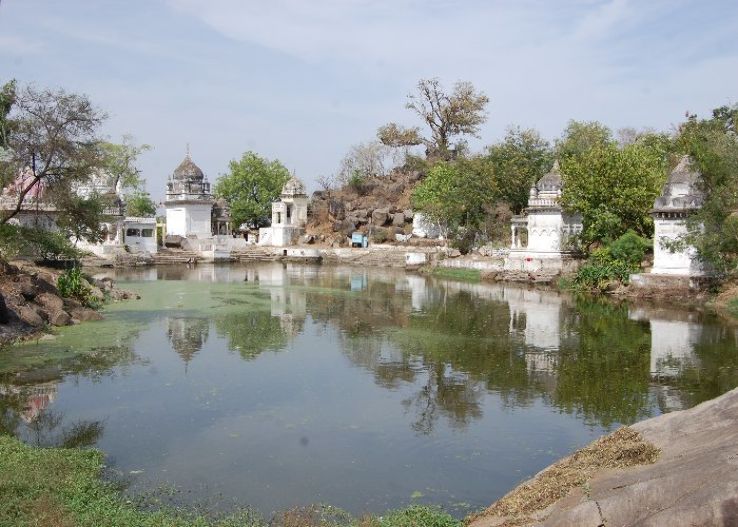For quite some time now, the city of Jabalpur has been a mere stopover for travellers exploring Madhya Pradesh’s deep, dense forests. It has also become a centre for students from neighbouring states to pursue their academic aspirations. One of the state’s largest cities, Jabalpur’s strategic location makes it a hub for commerce, industry and education to flourish, while also providing an impetus to tourism. But not many know of its own historical and cultural gems that have largely remained hidden from textbooks and maps.
Be it its lip-smacking cuisine that boasts of delicacies like the khoya jalebi, the magnificent heritage of marble art, splendid boat rides in the Bargi Dam reservoir, or the beautifully carved temples; there is a lot in Jabalpur for everyone. The name Jabalpur comes from the Arabic word ‘Jabal’ that means rock, and the Sanskrit word ‘pur’ which means city. It has been under several rulers and dynasties, and bears influences of all of them. Ashokan relics have been found quite close to the city, suggesting it was under the rule of the Mauryan Empire. The city was subsequently under Gondwana and the Maratha rule, and then under the British Raj, where it was made the capital of the Saugor and Nerbudda territories.
But while the history of this city is quite colourful, there is one iconic figure that stands out—a figure whose legacy is reflected in the natural and the built heritage of the city. Rani Durgawati Madavi, the ruling queen of Gondwana from 1550 to 1564 has been intrinsic to the very fibre of Jabalpur. And it is her legacy that we are set to explore in this magnificent city, one gem at a time, with a unique heritage walk organised on July 7 by Sahapedia through its outreach programme, ‘India Heritage Walks’.
Rani Durgawati, known for her zealous attitude and courage, was born in 1524 at the fort of Kalinjar in Uttar Pradesh. She was married off to Dalpat Shah Maravi, the eldest son of King Sangram Shah of the Gondwana region. The marriage gave impetus to the alliance of the Chandel and Rajgond dynasties. Soon after, in 1545, Rani Durgawati gave birth to Vir Narayan. Five years later, Dalpat Shah died. Given the young age of the heir, Rani Durgawati took over the reins of the kingdom and moved her capital to Chauragarh, situated in the Satpura hill range, because of its strategic importance.

The kingdom prospered under the rule of Rani Durgawati. She fought several battles—not just to keep her kingdom intact, but also to expand it. After fighting the Malwa rulers and capturing their territory, her state touched the border of the Mughal dominion. Durgawati put up a courageous fight against the Mughals, despite knowing that her army and weaponry were outnumbered by that of the Mughals. Towards the end of a bloody battle, which injured both her and her son, she knew that defeat was certain. Her mahout advised her to leave the battlefield, but Rani refused and killed herself with a dagger on June 24, 1564. Her martyrdom has been commemorated as Balidan Diwas by the Madhya Pradesh government.
During her rule, Rani Durgawati commissioned many gardens, temples and administrative buildings, which are still in use. We shall begin our walk at the Shail Parna Udyaan, a beautiful park with thick foliage, a lot of flora and a small lake. Here, one can escape the bustle of the city, hear the birds chirp and understand the natural heritage of the region. We shall then walk towards the Devtal group of monuments, which was built in the 13th century under the reign of Rani Durgawati.
Devtal literally translates to god’s lake, and the lake here is believed to be the oldest in the city. It is surrounded by small temples built in a similar style. The presence of these temples gives this otherwise serene and simple setting a royal touch. During the course of the walk, we shall discuss the architectural nuances of the temple, along with their history and significance.

But there is more to this walk than just walking and talking. Heritage is best understood by observation and interpretation. Its cultural and social nuances are only discovered when one delves into its details, and relates to it at a deeper level. Thus, participants are encouraged to carry their sketchbooks and interpret the heritage through their art. Towards the end of the walk, we shall have a sketching and painting session in the pristine environs of Devtal. Artists can indulge in either built or natural heritage. The selected entries shall be published online.
This walk shall be led by Medha Dube, the principal architect and founder of Medhira Designs, a multidisciplinary design firm, which is the very first conservation architectural firm of Jabalpur that works primarily on the undocumented and unprotected heritage of the city. Medha, a resident of Jabalpur, knows every nook and cranny of the city. She is also a vivacious storyteller and is an assistant professor at the Hitkarini College of Architecture and Town Planning. She regularly conducts heritage walks and talks in the city.
So, come discover the legacy of Rani Durgawati, explore the hidden gems of Jabalpur and give impetus to your artistic endeavours as you translate heritage onto paper.
This guided tour is free.
To learn more about the rich culture and heritage of Madhya Pradesh on Sahapedia, click here.
For more details and registration, click here.
References
https://books.google.com.au/books?id=HiOyJuxqZv4C&pg=PA8#v=onepage&q&f=false
https://www.sahapedia.org/search/content?keys=Madhya+Pradesh
https://en.wikipedia.org/wiki/Rani_Durgavati
https://byjus.com/pdf/Medieval-India-Satish-Chandra.pdf
http://www.pradeshtoday.com/newsdetails.php?news=Shreeji-mass-sedan-behold-Umde&nid=57315

